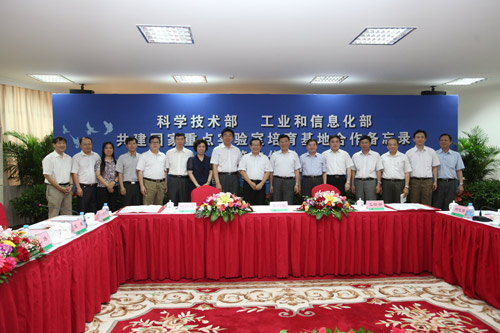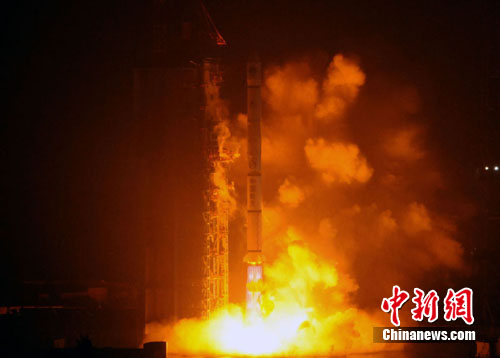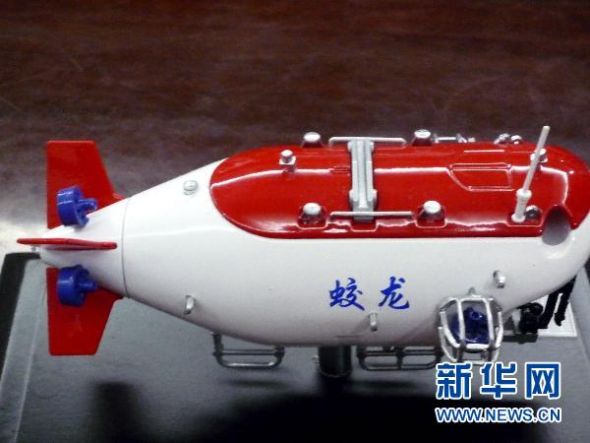CHINA SCIENCE AND TECHNOLOGY
NEWSLETTER
The Ministry of Science and Technology
People's Republic of China
|
|
|
N0.626 |
July 30, 2011 |
|
|
|
|
|
|
|
|
IN THIS ISSUE
|
|
*Partnership for 863 Projects
*MOST and MIIT Cooperation on Key Labs
*Inter-Ministerial Consultation between MOST and Ministry Of Culture
*1,000 Studios for Skill Masters
* Space Technology for World Heritage Protection
* New Navigation Satellite Launched
* Manned Submersible Hits 5000m
|
Partnership for 863 Projects


A working meeting was held on July 18, 2011 to foster partnerships between the implementers of the National 863 Program at the Binhai New Area in Tianjin. WAN Gang, Vice-Chairman of Chinese People’s Political Consultative Conference and Minister of Science and Technology, and HUANG Xingguo, Mayor of Tianjin, were present at the event. At the meeting, head of the 863 Joint Office spoke about the implementation of the urban partnership project staged to transfer the S&T findings derived from the National 863 Program and associated supporting policies. Senior officials from Tianjin Science and Technology Committee and Binhai New Area reported the construction of the infrastructures for spinning-off the S&T findings derived from the 863 Program.
According to the partnership project, MOST and Tianjin Municipal Government will work on four pilot fields in the first place, including new generation information technology, biomedicine, high-end equipment manufacturing, and new energy, and establish industrial centers, incubators, and generic technology platforms for the purpose. 90 cooperation projects under the 863 Program were undersigned at the event for commercial applications at Binhai New Area, with a total investment worth RMB 2.78 billion.
MOST and MIIT Cooperation on Key Labs

July 14, 2011, WAN Gang, Vice-Chairman of Chinese People’s Political Consultative Conference and Minister of Science and Technology, and MIAO Wei, Minister of Industry and Information Technology, attended an MOU signing ceremony to jointly establish a national key laboratory breeding center.
WAN thought highly of the important position and role played by national key laboratories in social advancement and technological development, emphasizing the close ties between the capacity building of national key laboratories and the national economic and industrial development. WAN applauded the accomplishments achieved by Beijing Polytechnic University Complex System Intelligent Control and Decision-Making Lab, saying that a key lab should have its own focus and well defined application orientation. Meanwhile, efforts shall be made to enhance basic research and original innovation capability, providing improved services to the economic and social development, expanding international exchanges and cooperation, and constantly raising the management level. WAN added that MOST and MIIT will support the development of the Complex System Intelligent Control and Decision-Making Lab, and the development of the Lab will in turn spur up the development of the University, facilitating personnel training, technology innovation, and international cooperation.
Inter-Ministerial Consultation between MOST and Ministry Of Culture


The first inter-ministerial consultation meeting between the Ministry of Science and Technology and the Ministry of Culture was held on July 26 at the National Museum. WAN Gang, Vice-Chairman of Chinese People’s Political Consultative Conference and Minister of Science and Technology, and CAI Wu, Minister of Culture, attended the meeting. The two sides reached the consensus on the theme, missions, goals, and mechanisms of the consultation system, and jointly inked two protocols on establishing a consultation system between the two ministries.
According to the protocols, the two government agencies will jointly initiate and implement special actions to build an innovation system conducive to the integration of culture and technology, and explore the new mechanisms and policies desirable for promoting the marriage of culture and technology during the 12th Five-year Plan period (2011-2015), taking advantage of the strength in their respective area. In 2011, the two ministries will jointly screen out the candidates to be technology and culture integration demonstration centers, in line with the National Joint Action for Technology and Culture Integration (2011-2015), and develop key technologies for theater performance and associated demonstration.
1,000 Studios for Skill Masters
The CPC Central Committee Organization Department and the Ministry of Human Resources and Social Security recently released a medium and long term plan to enhance the capacity building of highly skilled personnel for the period of 2010-2020. According to the Plan, as of the end of 2020, China will build some 1,000 national studios for Grand Skill Prize winners, skill masters working at major tech sectors and groups, and for the masters who are good traditional and unique skills.
The Plan says China will encourage enterprises to create more channels for the development of highly skilled personnel, along with appropriate incentives, guiding them to work for the industry with improved skills and techniques. Meanwhile, efforts shall be made to practice the socalled designation system, allowing highly skilled people to play a key role in the key posts, encouraging enterprises to foster their skill leaders, with due funding and personnel support. All levels of government and industries are encouraged to give highly skilled personnel an enhanced role to play in training, technology development, and skills sharing, and to build masters studios for them.
|
INTERNATIONAL COOPERATION |
Space Technology for World Heritage Protection
July 24, 2011, UNESCO inaugurated the establishment of the world's first space technology based world heritage research and training institution at an inaugural meeting held in Beijing. The UNESCO International Centre on Space Technologies for Natural and Cultural Heritage is designed to provide technical support to the monitoring, protection and management of the world heritages on the soils of UNESCO members, taking advantage of the space and earth observation strength of CAS Earth Observation and Digital Earth Center.
The new center will be governed under the leadership of the Governing Council. It will provide technical support to the monitoring and protection of world heritages, especially in Asia and Africa, in the form of technical training and capacity building, through the platform of UNESCO and international cooperation.
Archaeopteryx is an Early Deinonychus

The journal Nature published on July 28, 2011 the findings reported by XU Xing and coworkers at Chinese Academy of Sciences Institute of Vertebrate Paleontology and Paleoanthropology, which claims that Archaeopteryx belongs to the early family of Deinonychus, rather than the basal birds that werewidely accepted before, and therefore, it should not be considered as the earliest bird, based on the latest phylogenetic analysis.
Over the past decades, scientists have unearthed numerous fossilized feather dinosaurs and primitive birds across Rehe in western Liaoning. XU and coworkers found that Archaeopteryx looks more like the family of Deinonychus in overall shape, and distances itself from the fossilized birds that are found in the same area.
Xu said scientists have so far gathered 89 species of the early birds and 384 morphological
parameters for them. Each analysis involves the comparison between all the species available, in an attempt to determine their positions in the tree of life. When adding Xiaotingia zhengi in the 'tree of life' for reposition, scientists found that Archaeopteryx sits in the family of Deinonychus.
Advanced High-Speed Bearing Test Rig
A high-speed thrust bearing test rig, developed by Dongfang Electrical Machinery Corporation, was recently put into operation in Deyang City, Sichuan Province. It took more than one year for the developers to work out China’s first high-speed thrust bearing test rig featured with a maximum speed of 750 rpm, a maximum load capacity up to 2,000 tons, a maximum test outer diameter of 2,800mm, and a drag motor power at 4,500 kW. The drive system is made up of an AC motor and a high frequency component. An all-digital flexible control system is employed for both test and control. The test platform is able to simulate the work of a 6000-ton turbine generator’s thrust bearing model and the full-scale bi-directional thrust bearing operation of a pump-storage unit, accommodating the needs of testing giant facilities.
Novel Maintenance Coating for Asphalt Surface
A novel asphalt surface maintenance coating material, developed by Qingdao Runbang Chemicals, was recently put into mass production. The new material is a mix of high quality petroleum asphalt, modified and emulsified SBS and EPS, heavy oil liquid, high sulfur carbon, polymer latex, and inorganic calcium wear-resistant materials. The new product can be employed to repair tiny cracks and make them waterproof, while enhancing the wear resistance of the road surface, raising the temperature of the bridge surface, accelerating snow melting, reducing the noise, and making road and bridge surfaces more comfortable for driving.
The coating material, when sprayed onto the road surface, can rapidly penetrate into the tiny cracks on the road surface, and become a binder to the aging asphalt, desirable for filling up the tiny cracks at a depth of 10mm and with a width of 3mm. The novel material can also form up an irregular grid structure on the road surface, desirable for preventing further loosening and widening of the cracks, preventing rain water or fuel erosion to the road surface, delaying aging, and enhancing the stability of asphalt pavement surface.
New Navigation Satellite Launched

At 0544, July 27, 2011, China blasted off another navigation satellite aboard a CZIIIA launch vehicle, from the Xi’chang Satellite Launch Center. The new satellite, the ninth of its kind launched by China and the fourth inclined geosynchronous orbit satellite launched to form up a Compass satellite navigation network, has entered the preset orbit.
The regional part of China's Compass navigation system has been basically completed of its construction, and entered the test and evaluation stage. The initial tests have confirmed the smooth running of the system. The navigation system is scheduled to provide a range of services, including continuous passive positioning, navigation, time service, and short-message communication, to the users in China and its adjacent areas at the end of this year, accommodating the needs of transportation, fishery, forestry, meteorology, telecommunication, water resources, surveying, mapping among others.
According to the three-step strategy defined for the development of Compass satellite navigation system, China will launch more satellites before the end of 2012 to enhance the navigation network, improving the performance and expanding the coverage. China will complete the deployment of the global Compass satellite navigation system around 2020, providing high-precision and highly reliable positioning, navigation and time services for its global users.
Manned Submersible Hits 5000m

China's first manned submersible boat "Dragon" was released at 3:38, July 26, 2011 (Beijing time) to head for the 5000m destination depth. The submersible started to descend at 03:57 at a speed of 40m a minute. It completed its 5000m sea trials by hitting the depth of 5038.5 m at 6:12. The development implies that China’s "Dragon" submersible is able to reach more than 70% of the seabed across the global.
Designed for a depth of 7,000m, "Dragon" is supposed to test the depth of 7000m in 2012.
China Launched Practice-1102

At 1542, July 29, 2011, China blasted off a satellite named Practice-1102 aboard a CZIIC launch vehicle, from the Jiuquan Satellite Launch Center. The satellite will be employed to stage space experiments.
Fast Neutron Reactor into Operation
China Experimental Fast Reactor, China's first fast neutron reactor, became part of the operational power grid on July 21, 2011. Designed with an advanced pool structure, the experimental fast reactor is able to produce a nuclear thermal power of 65MW, and an electricity power of 20MW. With a system configuration and main parameters similar to a large fast reactor, the reactor is one of the few high-power experimental fast reactors that are able to generate electricity, enjoying an enhanced safety performance up to the criteria designed for the 4G nuclear energy system.
Lubricants for Space Components
Lanzhou Institute of Chemical Physics, part of the Chinese Academy of Sciences, has recently rolled out a silicon hydrocarbon compound, desirable for lubricating the moving parts of space components, thanks to its excellent thermal decomposition and high/low temperature performance.
China's First Internet Domain Name Center
China's first internet domain name engineering center was inaugurated on July 26, 2011 in Beijing. The new center is created to develop the core technologies for managing internet domain names, addressing domain name infrastructures and associated security issues through market means.
According to a briefing, as one of the 16 engineering research centers defined by Beijing Municipal Development and Reform Committee for 2010, the center is built and operated by NetChina, an internet infrastructure service provider. It will mainly work on massive intelligent cloud service, security and anti-cyber attack operation, distributed monitoring, next generation internet applications, software/hardware among others. Meanwhile, it will work out strategies for operations, monitoring, customer service, and consultation at different levels, in an effort to build a more convenient and safer internet environment.
Comments or inquiries on editorial matters or Newsletter content should be directed to:
Department of International Cooperation, MOST 15B, Fuxing Road, Beijing 100862, PR China Tel: (8610)58881360 Fax: (8610) 58881364
http://www.most.gov.cn

